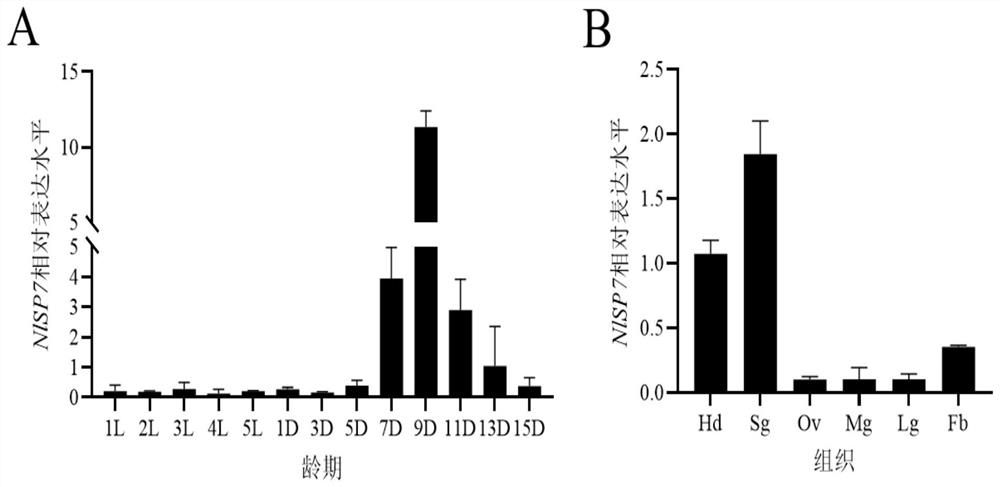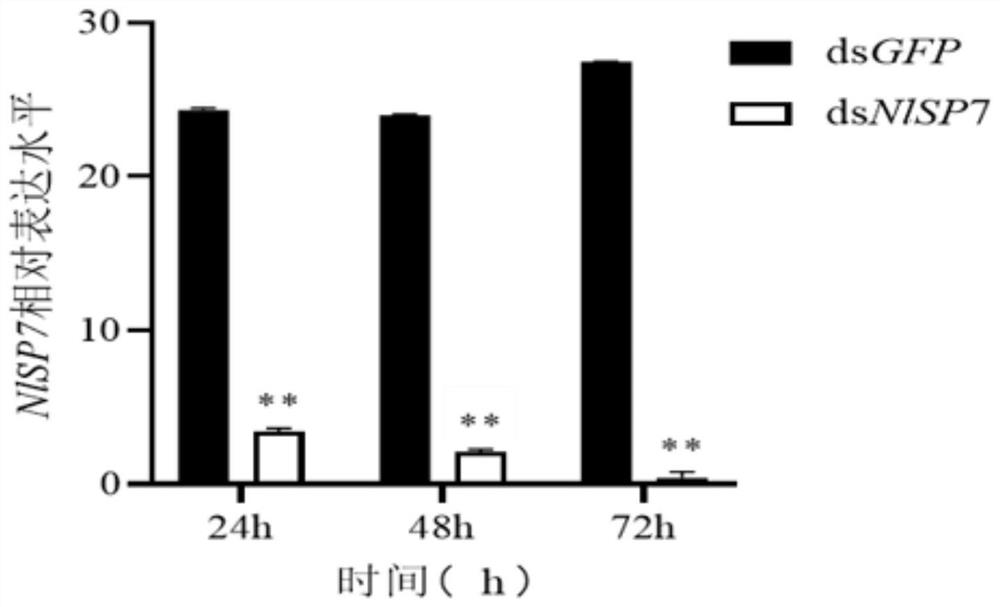Application of nilaparvata lugens NLSP7 as target in prevention and control of nilaparvata lugens
A brown planthopper and target technology, applied in the biological field, can solve problems in a specific period or in a specific tissue, and achieve the effect of increasing the content
- Summary
- Abstract
- Description
- Claims
- Application Information
AI Technical Summary
Problems solved by technology
Method used
Image
Examples
Embodiment 1
[0054] Cloning of embodiment 1 brown planthopper NLSP7 gene
[0055] Take 30 brown planthoppers fed with RH rice for multiple generations, and extract total RNA. The total RNA of the female adults of brown planthoppers was extracted using the Trizol method. The specific operations are as follows:
[0056] 1) Put the N. lugens samples into grinding tubes, freeze them rapidly in liquid nitrogen, add 100 μL Trizol reagent and grind them thoroughly on ice immediately.
[0057] 2) Add 900 μL of Trizol reagent, pipette and wash the remaining N. lugens tissue on the grinding rod, mix well, and let stand at room temperature for 5 minutes.
[0058] 3) Add 200 μL Trichloromethane (trichloromethane), shake rapidly for 15 seconds, and let stand at room temperature for 20 minutes.
[0059] 4) Centrifuge at 12,222 g for 15 min at 4°C.
[0060] 5) Aspirate the supernatant, add 500 μL Dimethylcarbinol (isopropanol), shake rapidly for 15 seconds, and let stand at room temperature for 20 minu...
Embodiment 2
[0077] Example 2 NLSP7 gene in different tissues and different ages in brown planthopper
[0078] Six different tissues (including fat body, head, foot, midgut, ovary, and salivary gland) of brachypterous female adults of N. lugens subcultured on rice variety RH were dissected under a body microscope using tweezers and insect needles in a clean environment , each treatment was repeated 3 times. Extract the total RNA of each tissue respectively, reverse transcribe after being the cDNA of the first strand (the specific method is the same as embodiment 1), use the quantitative reagent of Roche Company to carry out the fluorescent quantitative PCR technique to detect, the components of the fluorescent quantitative PCR reaction solution are as follows: Table 3 shows.
[0079] Table 3 Components of Fluorescent Quantitative PCR Reaction Solution
[0080]
[0081] The above reaction solution was dispensed into 3 wells of a 384-well plate, about 10 μL in each well.
[0082] PCR r...
Embodiment 3
[0091] The preparation of embodiment 3dsRNA
[0092] 1) Use the complete cDNA sequence obtained by inversion in Example 1 as a template, and NLSP7-F2 and NLSP7-R2 as primers for PCR amplification. The PCR amplification system is shown in Table 4. PCR reaction procedure: ① Pre-denaturation at 95°C for 5 minutes ; ② 35 cycles of 95°C for 30s, 57°C for 30s, and 72°C for 40s; ③ 72°C extension for 10 minutes; the final PCR amplification product 1 was stored in a 4°C refrigerator.
[0093] Table 4 PCR reaction system
[0094]
[0095] NLSP7-F2: ATGAGGGCTGCCCTGATT (SEQ ID NO. 4);
[0096] NLSP7-R2: TAGACAACCTGTGGTCCA (SEQ ID NO. 5);
[0097] Wherein, the underlined region is the T7 RNA polymerase promoter sequence.
[0098] 2) Use the plasmid containing green fluorescent protein GFP (GenBank: ACY56286) as a template, GFP-F, GFP-R as primers to perform PCR amplification to obtain PCR amplification product 2. The PCR reaction system is as shown in Table 5. The PCR reaction Proce...
PUM
| Property | Measurement | Unit |
|---|---|---|
| area | aaaaa | aaaaa |
Abstract
Description
Claims
Application Information
 Login to View More
Login to View More - R&D
- Intellectual Property
- Life Sciences
- Materials
- Tech Scout
- Unparalleled Data Quality
- Higher Quality Content
- 60% Fewer Hallucinations
Browse by: Latest US Patents, China's latest patents, Technical Efficacy Thesaurus, Application Domain, Technology Topic, Popular Technical Reports.
© 2025 PatSnap. All rights reserved.Legal|Privacy policy|Modern Slavery Act Transparency Statement|Sitemap|About US| Contact US: help@patsnap.com



